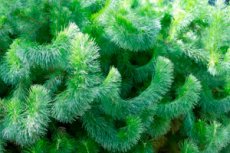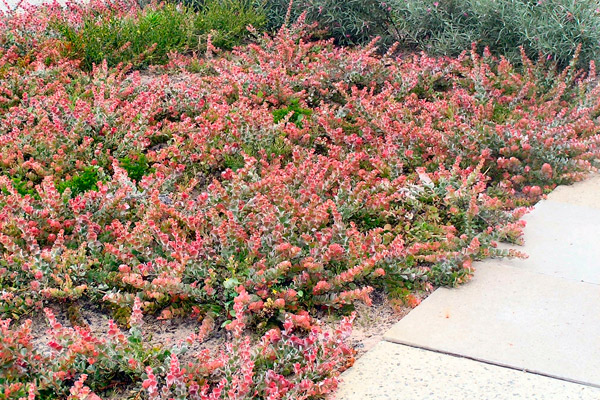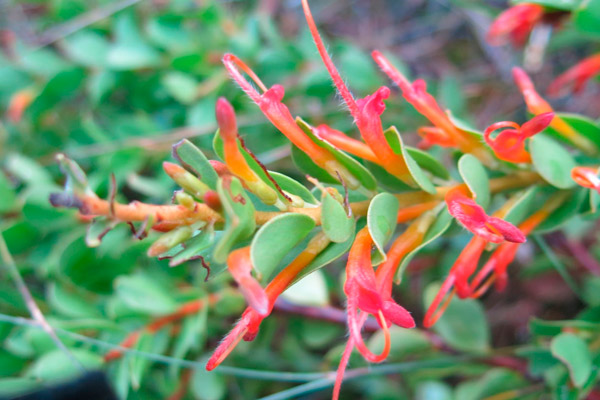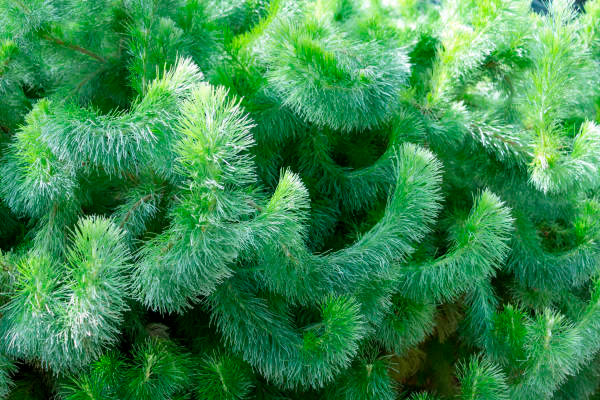New publications
Plants
Adenanthos
Last reviewed: 29.06.2025

Adenanthos (lat. Adenanthos) is a genus of evergreen shrubs and small trees belonging to the Proteaceae family. Plants of this genus are valued for their unusual leaf shapes and bright inflorescences, which retain their decorative appeal for a long time. In nature, adenanthos is mainly found in the southwestern regions of Australia, where sandy soils and a relatively mild Mediterranean climate prevail. In cultivation, this plant is rare, but in recent years it has been gradually gaining popularity among lovers of exotic garden plants and collectors.
Etymology of the name
The name "Adenanthos" comes from the Greek words "aden" (gland) and "anthos" (flower), which can literally mean "glandular flower." This designation refers to the characteristic features of the flowers and anthers, which have unique growths or glands. In botanical tradition, the genus solidified its name due to the special shape of the floral parts, distinguishing adenanthos from other Proteaceae.
Life form
Adenanthos typically grows as an evergreen shrub, forming a dense crown with short internodes and narrow, often pointed leaves. The shrub's height can range from 0.5 to 2 meters depending on the species and growing conditions.
Under favorable climatic conditions, some species of adenanthos may take on the form of small trees. Their trunks may slightly become woody, and the branches form a spreading crown. However, even tree forms rarely exceed 3–4 meters, making them easier to use in landscape design or container cultivation.
Family
Adenanthos belongs to the Proteaceae family, which includes about 80 genera and more than 1600 species, primarily found in the Southern Hemisphere. This family also includes such well-known genera as Protea, Banksia, and Grevillea. A common feature of the Proteaceae family is the unique structure of the inflorescences and seeds, adapted to harsh conditions, often with nutrient-poor soils.
Many members of Proteaceae have tough leaves and a specific root system that aids in the absorption of phosphorus and other limited elements. This allows them to survive on sandy and rocky soils. Adenanthos, as a member of this group, also has a developed root system and certain resistance to dry periods.
Botanical characteristics
Adenanthos leaves are usually thin, linear or lanceolate, with a smooth or slightly pubescent surface, and are arranged in a spiral or alternately along the stems. Inflorescences in different species can be single or grouped into small clusters; the flowers are often tubular or bag-shaped and may be red, pink, orange, or yellow in color.
The anthers and ovary of some species have special glands that secrete nectar or other substances. The fruits are nuts or seeds, often equipped with a tuft that facilitates wind dispersal. The root system is superficial but well-branched, allowing the plants to effectively extract moisture and nutrients from poor soils.

Adenanthos cuneatus
Chemical composition
Studies of the chemical composition of adenanthos are fragmented. It is assumed that the leaves and flowers contain flavonoids, which give color, as well as some phenolic compounds that serve a protective function. The inflorescences may contain nectar in small quantities, which helps in pollination by insects and birds.
Information on toxic substances in adenanthos is limited, but, like many Proteaceae, the plant may contain substances that potentially cause irritation in people with heightened sensitivity. Data on its pharmacological activity are scarce and require further research.
Origin
The genus Adenanthos originated and developed in the unique conditions of the flora of southwestern Australia, where low rainfall prevails during the warm months and relatively stable cool winters. Evolution in soils with low nutrient content led to the development of special root structures that facilitate the absorption of phosphorus.
The distribution of adenanthos is mainly limited to Australia, although some species may be introduced to similar climatic zones on other continents. Experiments on acclimatization of certain species have been conducted in South Africa and California, but widespread cultivation has not yet gained popularity.
Ease of cultivation
Adenanthos cannot be considered an easy plant to grow, as it requires specific conditions that closely resemble its native climate. It needs well-drained soil, poor in organics but capable of maintaining moderate moisture. Sharp temperature fluctuations and excessive humidity can negatively affect growth.
However, with the right substrate and proper watering, adenanthos can grow successfully in containers or open ground in regions with mild climates. Beginners in gardening are recommended to carefully study the plant's needs before attempting cultivation.
Species and varieties
The genus Adenanthos includes about 30 species, many of which are little studied in cultivation. The most well-known are:
- Adenanthos sericeus (or "silvery adenanthos") — with soft, silky leaves and interesting pinkish-red flowers;
- Adenanthos cuneatus — a smaller species with wedge-shaped leaves and slightly orange flowers;
- Adenanthos obovatus — characterized by round leaves and a compact habit. Varieties of adenanthos in nurseries are relatively rare, as breeding work with adenanthos is still gaining momentum.

Adenanthos obovatus
Size
In its natural habitat, adenanthos can grow from 0.3 to 2 meters tall, depending on the species and growing conditions. Some representatives can take the form of small trees up to 4 meters in height, but these forms are relatively rare.
When grown in containers, the plant's size is usually more modest, as the volume of the pot and the characteristics of the substrate limit root growth. If desired, the height and shape can be controlled by pruning and crown shaping.
Growth rate
The growth rate of adenanthos cannot be considered fast. Typically, under favorable conditions, the shoots may elongate by 10–20 cm in a single growing season. More dynamic growth is observed in young specimens, which actively form new branches and leaves.
In the case of insufficient light, excessive watering, or an overly nutrient-rich soil, growth may become irregular, and the overall health of the plant may decline. A balanced approach to agriculture allows for healthy and stable growth.
Lifespan
In its natural environment, adenanthos can live for several decades, gradually forming a branching shrub with a stable root system. In cultivation, with proper care and the absence of extreme conditions (sharp overwatering or severe frosts), the plant can maintain its decorative appearance and flowering ability for 7–10 years or more.
As it ages, adenanthos may show partial exposure of the lower part of the trunk. To maintain its appeal, rejuvenating pruning is carried out to stimulate the growth of new shoots and extend its lifespan.
Temperature
The optimal temperature for adenanthos ranges from 15–22 °C, although mature plants can tolerate short periods of higher temperatures if adequate watering and ventilation are provided. In winter, a temperature drop to 10–12 °C is acceptable, provided the plant is not subjected to direct frosts or prolonged chilling.
In regions with cold winters, adenanthos is typically grown in containers, moving them to cool but frost-free rooms. Sharp temperature fluctuations negatively affect metabolism, so a stable temperature regime is crucial for the plant's health.
Humidity
Adenanthos does not have strict requirements for air humidity, as it naturally grows in regions with moderate rainfall. However, excessively dry air combined with high temperatures can lead to rapid moisture evaporation through the leaves, ultimately causing the shoots to wilt.
Moderate humidity (about 40–60%) is considered optimal. In the case of excessively dry indoor air, it is recommended to periodically spray the leaves, especially during the hot season or when heating is on.
Lighting and placement in the room
Adenanthos prefers bright but diffused light. Direct midday sunlight, especially in summer, can scorch the delicate shoots. The optimal placement is on an east or west-facing window, where the plant receives plenty of light in the morning or afternoon but is not harmed by intense midday sun.
When lighting is insufficient, adenanthos will become leggy, the leaves will become less dense, and flowering may not occur. During winter, it is useful to supplement the light with grow lights to compensate for the reduced daylight hours.
Soil and substrate
The optimal mixture for adenanthos consists of 40% universal soil (with a neutral or slightly acidic reaction), 20% peat, 20% coarse-grained sand or perlite, and 20% leaf mold. In conditions as close as possible to the natural environment, a small amount of fine gravel or vermiculite can be added to the substrate.
The recommended pH of the soil is 5.5–6.5. A drainage layer of 2–3 cm thick, made of expanded clay or gravel, is mandatory. Overwatering is unacceptable, as the roots of adenanthos are sensitive to water stagnation.
Watering (summer and winter)
In summer, watering should be regular but moderate. The soil should slightly dry out at the top between waterings to prevent root rot. In hot weather, the watering frequency can be increased, but the roots should not be left in water for extended periods.
In winter, the watering intensity is reduced, especially when the plant is kept in a cooler room. Watering every 1–2 weeks is sufficient, depending on how quickly the substrate dries out. Overwatering in cold weather leads to root rot and leaf loss.
Fertilization and feeding
Adenanthos responds well to fertilizers but does not tolerate excess phosphorus. It is best to use balanced mineral fertilizers with moderate phosphorus content and a well-balanced mix of trace elements. Fertilizations are applied every 3–4 weeks during the active growing season (from spring to early autumn).
The fertilization methods include root feeding with a solution or the distribution of granular fertilizers on the soil surface. It is essential not to exceed the recommended dosages, as an excess of nutrients can harm the plant just as much as a deficiency.
Flowering
Many species of adenanthos produce unusual tubular or bell-shaped flowers that appear at the tips of the shoots or in the leaf axils. The flowers range in color from red and pink to orange and yellow. The flowering period occurs during the warm months, although the exact timing depends on the species and growing conditions.
To stimulate flowering, it is essential to maintain a stable temperature, abundant but controlled watering, and adequate light. Unfavorable factors (overdrying, sudden temperature fluctuations) can lead to bud drop and delay the formation of new inflorescences.

Adenanthos sericeus
Propagation
Adenanthos is primarily propagated by seeds and cuttings. Seed propagation is more troublesome: pre-stratification or scarification of the seeds is required, and the germination period can last several weeks. Young seedlings grow slowly and require careful care.
Cutting semi-woody shoots allows for faster propagation. The cuttings are rooted in moist, well-drained substrate at a temperature of 20–25 °C. Under favorable conditions, the root system forms in 3–6 weeks.
Seasonal features
From spring to autumn, adenanthos actively grows, forms new shoots, and sets flower buds. During this time, more frequent watering and regular fertilization are required. The optimal daytime temperature is around 20–25 °C.
In autumn and winter, growth slows down, although adenanthos does not enter a full dormant state. When kept in cooler conditions (15–18 °C) and with reduced watering, the plant rests, which has a positive effect on overall health and future flowering.
Care features
Adenanthos requires strict control of watering: even brief water stagnation in the soil can cause root rot. Another important aspect is ensuring adequate lighting to prevent leggy shoots and weakened plant immunity.
Regular inspection of the leaves and shoots allows problems (yellowing, wilting) to be noticed and corrected promptly. If necessary, the plant can be sprayed with soft water to reduce leaf drying.
Care at home
The first step is to choose the right spot for adenanthos: the best option is an east or west-facing window with diffused light. If placed on a south-facing window, shading during midday hours should be provided.
The second key aspect is proper watering. Watering should be more frequent in summer, but overwatering should be avoided, and in winter, watering should be reduced to a minimum. A soil moisture meter can be used to check moisture levels or the substrate can be checked by feel.
The third point is regular fertilization. During the active growing season (April–September), use mineral fertilizers with a balanced composition, avoiding high doses of phosphorus. Fertilize every 3–4 weeks.
Finally, it is essential to monitor the temperature regime and humidity level. In excessive heat, the plant can be sprayed and the room ventilated, while in temperatures below 15 °C, reduce watering and protect adenanthos from chilling.
Transplanting
Choose a pot for transplanting that is 2–3 cm larger in diameter than the previous one, avoiding excessively spacious containers. It is best to transplant by gently removing the root ball without disturbing it to avoid damaging the roots. The optimal time for transplanting is early spring, before the active growing season begins.
The material of the pot (ceramic, plastic) is of little importance, but the pot must have drainage holes and a layer of expanded clay or gravel for water drainage. After transplanting, shade the plant for 2–3 days and limit watering.
Pruning and crown formation
Adenanthos usually does not require intensive formative pruning, but shortening excessively elongated shoots will help maintain a compact appearance and stimulate branching. Pruning should be done in late winter or early spring, using sharp, sterile secateurs.
Cuts should be made above an outward-facing bud to encourage the crown to spread outward rather than inward. Remove dry, diseased, or weak shoots to improve light penetration and air circulation inside the bush. Pruning helps rejuvenate the plant and gives it a more neat appearance.
Possible problems and solutions
The most common problems are root rot and fungal diseases, which arise from overwatering and poor drainage. Signs include wilting and darkening of the leaves, mold growth on the substrate surface. The solution is to reduce watering, improve drainage, and possibly treat with fungicides.
Nutrient deficiencies (especially nitrogen or iron) result in yellowing of the leaves and stunted growth. Regular feeding with balanced fertilizers and maintaining the proper soil pH can quickly restore the plant. Care mistakes, such as inadequate lighting, can lead to leggy growth and weak flowering.
Pests
Pests that may attack adenanthos include spider mites, aphids, and thrips. These insects thrive in hot and dry conditions. Signs include fine webs, sticky residue, or pinpoint damage to the leaves.
Prevention involves regular inspection and spraying the plant with water. In cases of mass infestation, use insecticides according to the instructions. Some gardeners prefer to use biological treatments based on entomopathogenic fungi or soap solutions for leaf treatment.
Air purification
Like many evergreen shrubs, adenanthos releases oxygen and absorbs carbon dioxide, which helps improve the indoor microclimate to some extent. Its large leaves capture fine dust particles, contributing to the partial purification of the atmosphere.
However, the plant does not play a significant role in filtering harmful substances, so it should not be considered as the "primary air purifier." Regularly wiping the leaves improves their ability to photosynthesize and further reduces the dust levels in the room.
Safety
Adenanthos is not considered toxic to humans or animals upon casual contact with the leaves or shoots. However, it is always recommended to exercise caution and wash hands after pruning or transplanting, especially for individuals with sensitive skin.
Allergic reactions to adenanthos pollen have not been documented, but people with heightened sensitivity may experience individual reactions to trace elements or essential oils in the plant. If irritation occurs, it is advised to consult a specialist.
Wintering
In regions with mild climates, adenanthos can overwinter outdoors if the temperature does not drop below 5–7 °C. In severe frost, it is better to move the plant to a cool room (10–12 °C) with limited watering.
Preparing for winter includes stopping fertilization in late autumn and reducing watering frequency. If adenanthos is kept at room temperature, it may continue slow growth, but flowering during the short daylight hours is usually not possible.
Useful properties
The main value of aden
Anthos is its aesthetic appeal: its unusual leaf shapes and striking flowers give the plant a unique appearance, allowing it to be used as a decorative accent in landscapes or interiors.
Some researchers suggest possible antimicrobial properties of essential oils in certain Proteaceae, but the practical application of adenanthos for medicinal purposes remains unproven and is limited to local traditions.
Use in traditional medicine or folk remedies
There is no information about widespread use of adenanthos in traditional medicine. In certain regions of Australia, local people may use parts of the plant (bark, leaves) for making decoctions, but scientific evidence of the efficacy of these recipes is lacking.
When gathering parts of adenanthos for folk remedies, one should remember the potential for individual intolerance and the lack of systematic research. Any self-medication experiments should only be conducted after consulting a phytotherapist.
Use in landscape design
Adenanthos is often used in southern gardens and parks, where mild winters and sandy soils replicate the native Australian climate. Due to its compact size and low demand for frequent watering, the plant fits well into designer compositions combining different types of Proteaceae.
Vertical gardens and hanging compositions with adenanthos are less common, as the plant has a semi-woody structure and requires a sufficient amount of substrate. However, with the right support and regular care, it can become an interesting addition to a green wall.
Compatibility with other plants
Adenanthos grows well alongside plants that prefer slightly acidic or neutral soils and do not require abundant organic fertilizers. Plants that need high nitrogen levels may negatively affect adenanthos, as Proteaceae do not tolerate excess phosphorus and nitrogen.
In landscape compositions, adenanthos harmoniously combines with other representatives of Australian flora (Banksia, Callistemon, Eremophila) as well as some succulents. It is important to maintain the overall style of the composition and ensure similar soil and watering requirements.
Conclusion
Adenanthos is an interesting representative of the Proteaceae family, possessing high decorative value and adaptability when grown under the right conditions. Its delicate flowers and unique leaves can become a striking element in a garden or room, adding an exotic touch to compositions.
Successful cultivation of adenanthos requires careful adherence to agricultural techniques: proper soil selection, attentive watering control, and adequate lighting. When these conditions are met, the plant can delight the gardener with unusual shapes and a long period of decorative appeal.
